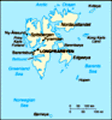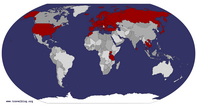Advertisement
Published: July 26th 2019
So the good news there are cats in Svalbard, the bad news is that I didn’t see any. Apparently they were smuggled illegally into the Russian communities and have become a little feral. One ginger cat has managed to get itself registered as an Arctic Fox, which is cunning because the latter are indigenous and therefore allowed. Despite being white in the winter, the foxes are red in summer, so it’s a very clever disguise for a ginger cat.
Svalbard is an archipelago of a few islands, most of which are uninhabited by humans and Spitsbergen being the largest where Longyearbyen is the capital with a steady population of 2000. It was originally inhabited by whaling communities until after a hundred years or so, when they almost hunted the whales into extinction. Then came the coal miners and there are around 9 mines, with only one left still working. It’s situated around 650 miles south of the North Pole, so has the midnight sun and long dark winters. Working as a miner here in bygone times must have been pretty depressing - it’s probably not the best laugh now.
We disembarked the ship around 8.30am and were instructed to
board the shuttle bus because the main town is a couple of kilometres away. We would have been better off walking as we waited ages before it went and I was getting impatient to see everything.
Longyearbyen is a very ugly industrial town set in such a clean and sparse landscape. There are no trees, but a bit of grass being munched down on by wild reindeer trying to get as fat as possible before the winter. The tiny purple, white and yellow flowers have petals only millimetres in size. The town has a school, kindergarten and university. There is a swimming pool and gym, plus cultural centre with cinema. Not only are you not allowed to die here (because you can’t be buried in the permafrost) but you can’t be born here either. This is because the small hospital isn’t equipped well enough should any complications occur.
On the edge of town is a knackered old building that is a social centre and nightclub combined. It didn’t look like the kind of place to play any banging tunes, but I guess when you’re so isolated you take what you can get. On the hillside were rows of
colourful houses, stilted at the front. They are not ugly and the very top ones are known as Beverly Hills and are occupied by the richer people in the area, more often than not, miners, as they are well paid here.
A shallow brown river oozes through the town, lined with machinery as the banks have to be reinforced every summer to prevent flooding. Quaint and pretty, this place is not. I think they are trying to smarten it up as tourism becomes more popular, but it is still a scar caused by humans exploiting the natural resources whilst surviving in a very inhospitable (to humans) land.
However, humans as always have made it inhospitable for every other living being here. After the decline of whaling, it became popular for hunters and trappers. Once it was teaming with wildlife including foxes, seals, walruses and polar bears. Now the only abundant wild animals are reindeer. Currently, there are laws that prohibit tourists from approaching wildlife, in the hope of protecting what’s left. However, you are allowed to approach wildlife if you are hunting, I kid you not. We were assured that it’s very closely monitored and limited, but still,
no one needs to hunt here, there’s plenty of imported food and warm clothing.
Glyn and I had booked a private tour with Spitsbergen Adventures, the plan being we had a tour tailored especially for us. Despite it being expensive, we believed worth it as Svalbard had been the main reason for this entire holiday. I WhatsApped the guy I’d been emailing only to discover he had left the company. Oh. He gave me the number of our guide, Misha, who when he answered the phone sounded quite sleepy. I was a little concerned but upon meeting him, I think he’s just very laid back.
Like all tour guides we have encountered on this trip, Misha is not Norwegian, but from the Ukraine, having moved here after visiting around 7 years ago. He drove us past the town limits where visitors are not allowed to pass without an armed guide in case of a polar bear encounter. I’ve heard that they shoot to scare away the bears, but polar bears are very dangerous, so there is a risk of them being killed because of idiot tourists.
Misha pointed out various Arctic birds and we took a few
photos to show willing, but I doubt birds will ever interest me unless they are totally multi coloured. We also saw quite a few husky dog centres, all for tourism. There was an option for a husky dog ride when we booked the cruise, (being pulled on wheels like horses pulling a carriage) but it looked naff. The dogs appeared happy enough as they still need exercise in summer and are not allowed to run wild as they are not indigenous.
Our first stop was up a hill to photograph the ugly town sprawled over a small corner of the landscape below. Behind us was a mine and a radar centre with two huge dishes. Misha told us that this centre was the reason why they have good broadband in Spitsbergen as it’s needed to send the research to the mainland. But like everything, it is very expensive. I think it was this mine that was still working and Misha said we could not get too close as Norwegian miners are very grumpy and anti social.
The road ended here, but some hikers passed us en route to a glacier some miles away.
No road goes any
further in this direction, because this was the farthest mine. We returned to the main road and turned up another hill, where it ended with another derelict mine. We soon learned that the few roads outside the town all terminate at a mine, pumping station or scientific centre, but usually a mine.
After a photo stop at the polar bear warning sign, we passed through the town and out the other side. Following the coast, we passed summer houses. I find this concept bizarre here as you are only allowed to have a summer house if you are a resident of Longyearbyen, and Longyearbyen is walking distance away. After spotting a few reindeer, no arctic foxes and a few empty looking houses, we reached a mine, so the end of the road. Misha brought his rifle, so we knew we were outside city limits. We were totally reassured to be told that to get a gun in Longyearbyen, all you need is proof that you don’t have a criminal record. Learning to shoot is not required, so don’t assume that just because you have an armed guard that you are protected.
So we’d seen the full width of Longyearbyen in an hour of so. In the winter it is possible to go much further with snowmobiles. Misha said the snow doesn’t get that thick, about a metre deep. Hmm, that’s pretty thick if you’re British! All over town are snowmobiles parked up, waiting for snow and adventure.
Lunch was at a picnic bench on the stony shore that was squishy with sea kelp. I’d lugged my tripod and filters thus far, so was determined to take some slow shutter images of the water, even if the photos turned out crap! I also got to use my macro on the tiny flowers. Our meal was freeze dried in a packet, Misha poured hot water from a flask and we were given large wooden spoons to stir. This food is lightweight for mountaineers and intrepid explorers, but good enough for us and like a posh pot noodle (mine was veggie cous cous) and surprisingly tasty.
The rest of the trip was driving around town, almost to the top, so now we’d been to just about everywhere you can without going on a long hike.
After the tour, Glyn and I had a small wander around the town and bought a fridge magnet and small cuddly polar bear. We walked back to the port as it’s close and no bus required if you are able to walk a mile - which does actually mean a lot of people on this cruise.
Back on board, the captain announced that we were going to cruise to a surprise glacier, the Tuna Glacier no less.
Tuna Glacier is still growing, blue and magnificent. We parked up (or anchored up if you’re nautical) by the glacier for four hours. I didn’t appreciate just how big the glacier is until a tender (small boat) chugged up to it and became barely a speck by comparison.
The reason for the tender going dangerously close to to the glacier was to carve some ice for premium drinks. This has mixed reactions from the people I’ve chatted to. One reaction is that it’s full of bird crap and other things most of us wouldn’t want to drink - this is why it fizzes in your drink. Another, is that the glacier is ancient and protected, so we shouldn’t be carving ice from it for vanity. And finally, during summer, glaciers are ‘calving’ (I learnt this term from tribe-explaining-woman) which means, huge chunks randomly break and drop off. If a boat is nearby, it’s game over for all onboard. To have someone risk their life so I can have a drink full of bird crap, destroying an ancient glacier doesn’t seem right to me. If I want to drink bird crap, I’ll scrape a statue in Stoke, thank you very much.
At times I thought I heard thunder, but this is the sound a glacier makes in summer as it cracks and moves. We watched it for as long as we could stay awake in the bright light of the late night. It is awesome to see such a wonder.
Advertisement
Tot: 0.069s; Tpl: 0.013s; cc: 9; qc: 29; dbt: 0.0381s; 1; m:domysql w:travelblog (10.17.0.13); sld: 1;
; mem: 1.1mb











